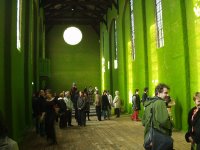
I've heard it said that life and culture in the United States runs not far behind that of Europe and generally speaking, I believe it. Dotted across Europe stand centuries old cathedrals that Sunday after Sunday go empty and unused. Abandoned decades (if not centuries) ago, some are converted for alternative usage. Many are not, left to ruin. Recently, one cathedral was invovled in an interesting transformation. In Southwark Park, London, England artist Michael Cross (interesting coincidental surname) recently exhibited a site-specific commissioned work entitled "Bridge."
While the artist's surname may be coincidence, that fact the exhibit takes place in a discarded church building I doubt is any coincidence at all. The following is a brief write-up I found:
Housed in a former church, (one of the earliest examples of poured concrete construction and a Grade II listed building), the piece comprises submerging two thirds of the inside of the church in water, and producing a series of steps which rise out of the apparently empty man-made lake’ as you walk across them. Each step emerges one step in front of you and disappears back underneath behind you as you go. This bridge is purely mechanical, the weight of the person on it depresses each step a little, this force activates a submerged mechanism which raises the next step.
The public are invited to  walk out on it as if walking on water, eventually reaching the middle of the lake, thirty steps and twelve meters from the shore. There they will stand alone and detached, stranded in the middle of a plane of water until they choose to return the way they came. For some people this experience of being cut off and surrounded by water will be peaceful, for others terrifying. For some walking across the water will be pure childish joy, whilst others will be too scared to try.
walk out on it as if walking on water, eventually reaching the middle of the lake, thirty steps and twelve meters from the shore. There they will stand alone and detached, stranded in the middle of a plane of water until they choose to return the way they came. For some people this experience of being cut off and surrounded by water will be peaceful, for others terrifying. For some walking across the water will be pure childish joy, whilst others will be too scared to try.
Honestly speaking, I have mixed emotions when I see this. I am impressed by the artistry and the engineering, but my heart sinks when considering if this is what is to become of churches in the US. Churches in this country are closing by the day. On the way to the church building in which I work, I pass several discarded church buildings now occupied by businesses or day care/schools. That alone is disturbing enough. How far are we from following in Europe's footsteps?
I guess what really troubles me is the interest, inquiry and the magnificent effort put forth to emulate an occurrance that Christ Jesus actually achieved in the flesh. Though magnificent in design and execution, isn't this art exhibit like handing a child a Stratavarius and expecting them to play Mozart? Something will fall miserably short in the process. It may feel like walking on water, but the most important experience is still left wanting!
I sincerely appreciate the asthetic experientialcial value of solitude and contemplation in a setting such as this. In fact, had I been in England during the run of this exhibition, I would have likely made a point of going and experiencing the "Bridge" myself. I'm all about tactile experience, especially ones that promote my continuing relationship with Jesus Christ. Merely being in a church building of that vintage does things to me anyway. It is emotionally stirring to stand gazing up into those flying buttresses and "hearing" the worship of saints long since departed.
 ationship with Jesus Christ will result in the experience of walking on water, I do believe we will experience more than we can ask or imagine (1 Cor. 2:6-16; Eph. 3:20).
ationship with Jesus Christ will result in the experience of walking on water, I do believe we will experience more than we can ask or imagine (1 Cor. 2:6-16; Eph. 3:20).There is a "bridge" to cross the great distance between where we are and where Jesus is. It is not found imitating His miraculous journey across water, it is found in knowing Him and being aware of how well we are known by Him. The "bridge" is relationship and that is something even a man named Cross can not achieve for his own. He too, finds it in submission to the One who is known by the Cross in order that we might begin "walking on water" with the One who actually did it in the first place.

No comments:
Post a Comment